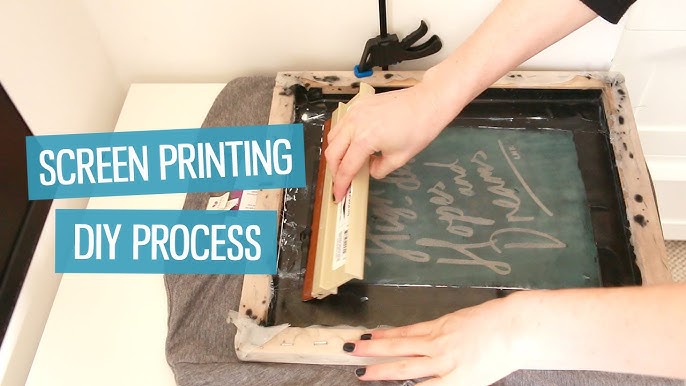ChatGPT said: How 10:9 Design Texas is leading the screen printing industry
The Important Guide to Recognizing Screen Printing and Its Versatile Utilizes
Screen printing has a rich background that goes back to ancient times, evolving right into a sophisticated strategy used across numerous markets today. This overview checks out the intricacies of the screen printing procedure, outlining its applications in fashion, advertising and marketing, and home design - 10:9 Design Embroidery. Comprehending these fundamentals can open imaginative potential for both commercial and imaginative jobs. The complying with areas will expose essential suggestions and methods to enhance one's screen printing ventures
The Background of Screen Printing
Screen printing has origins that map back centuries, its development shows the imaginative and technical developments of numerous societies. Coming from old China, the technique was at first used for decorating fabrics and later infect Japan, where it ended up being integral to Ukiyo-e woodblock printing. The technique shifted to Europe in the 18th century, where it obtained appeal among craftsmens and industrial printers. The innovation of photo emulsion in the 20th century reinvented screen printing, permitting more intricate styles and higher performance. Musicians like Andy Warhol better thrust its popularity, utilizing the medium to create famous jobs that blended commercialism and fine art. By the late 20th century, screen printing had actually developed itself as a functional method, employed in style, advertising and marketing, and fine art. Today, it proceeds to evolve, incorporating electronic innovation and increasing its applications across numerous industries.
The Screen Printing Process Explained
Screen printing transforms imaginative visions right into tangible designs through a collection of specific actions. A photo is produced and then moved onto a screen, normally made of great mesh textile extended over a frame. A light-sensitive emulsion is related to the screen, which is exposed to light, hardening in locations not covered by the image. After rinsing the unhardened emulsion, a pattern is formed.
Next off, the screen is placed over the substratum, whether it be material, paper, or another product. Ink is then pushed through the open areas of the pattern utilizing a squeegee, depositing the style onto the substratum below. This process can be duplicated for numerous shades, needing separate screens for each color. The printed thing is healed making use of heat to ensure the ink adheres properly, resulting in a sturdy, dynamic style all set for use.
Kinds Of Screen Printing Techniques
In addition, specialized techniques, such as discharge screen printing, remove dye from the material to produce softer prints, while aluminum foil screen printing applies metallic aluminum foil to achieve a glossy coating (10:9 Design near me). Each strategy provides unique qualities, accommodating different innovative demands and manufacturing ranges, eventually broadening the possibilities within the screen printing domain
Applications of Screen Printing in Various Industries

Furthermore, the signs and advertising sectors use screen printing for creating attractive display screens and banners. This technique permits for bold shades and complex layouts that catch focus. In electronics, screen printing is used for using conductive inks to circuit card, important for part connections. The home décor market welcomes screen printing to create unique styles on textiles and wall art. Generally, screen printing offers as a vital device across diverse fields, improving products with customized and aesthetically enticing graphics.
Tips for Successful Screen Printing Projects
While carrying out a screen printing job, mindful focus to detail can significantly improve the last end result. Initially, picking high-quality materials is necessary; this consists of the screen, inks, and substratums. Making use of ideal mesh matters can influence ink deposition and information resolution. Preparation is equally essential; extensive Visit Your URL cleaning of screens and proper exposure times assure crisp prints.
Next off, exact enrollment is right here important for multi-color prints. Using positioning tools can help accomplish specific layering. In addition, screening prints on scrap materials prior to manufacturing aids determine prospective problems without wasting sources.

Often Asked Concerns
What Products Are Best for Screen Printing on Fabric?
Cotton and polyester blends are perfect for screen printing on textile due to their durability and ink absorption. In addition, specialty fabrics like silk or canvas can produce special appearances and surfaces, enhancing the total style quality.
Just how Do I Clean and Maintain Screen Printing Tools?
To maintain and clean up screen printing equipment, one need to regularly clean displays with proper solvents, examine mops for wear, lube relocating parts, and shop all items in a dry, dust-free atmosphere to lengthen their life-span.
What Are the Environmental Effects of Screen Printing?
Screen printing can have significant environmental effects, consisting of chemical waste from inks and solvents, water use during cleaning procedures, and energy intake. Environment-friendly products and sustainable methods are important for decreasing these negative impacts.
Can Screen Printing Be Done at Home Efficiently?
Screen printing can be properly done at home with the right materials and methods. Hobbyists can develop quality prints, though success depends upon their skill degree, tools, and understanding of the procedure involved.
What Are the Expenses Associated With Beginning a Display Printing Business?

Beginning a screen printing service entails costs for equipment, materials, and workspace. Preliminary costs normally vary from a couple of hundred to a number of thousand dollars, depending on the range, high quality of machinery, and desired production capacity.
Screen printing has an abundant background that dates back to ancient times, developing into an innovative technique used across different markets today. One more method, rotary screen printing, uses cylindrical you can find out more screens, facilitating continual printing on material rolls, thus enhancing effectiveness for large-scale manufacturings. In addition, specialty strategies, such as discharge screen printing, eliminate dye from the fabric to develop softer prints, while aluminum foil screen printing applies metal foil to attain a shiny coating. In the style industry, screen printing is widely utilized to create lively designs on clothing, enabling brand names to showcase their one-of-a-kind styles. Cotton and polyester blends are ideal for screen printing on textile due to their sturdiness and ink absorption.